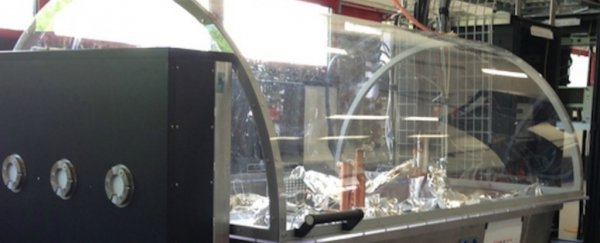Astronomers working with the European Space Agency's (ESO) Very Large Telescope (VLT) in Chile have just announced that a black hole-observing device called GRAVITY is now fully operational on all four of the VLT's 8.2 metre (26.9 foot) Unit Telescopes - and it's has already provided one accurate measurement.
This is huge news, because the power boost offered by GRAVITY will enable astronomers to observe the black hole at the centre of the Milky Way - a goal they've been working towards since its location was estimated back in 2002.
So how does it work? Basically, the device has the power to combine the strength of all four of the smaller Unit Telescopes that make up the VLT. "By combining light from the four telescopes, it can achieve the same spatial resolution and precision in measuring positions as a telescope of up to 130 metres in diameter," the team reports.
With all of this extra power, astronomers are able to accurately measure extremely distant objects that other telescopes cannot pick up. This includes finding and observing exoplanets, stars, and - most awesomely - black holes.
So far, GRAVITY has enabled scientists to examine a star called S2, which is orbiting Sagittarius A* (Sgr A*) - the hypothesised black hole at the centre of our galaxy. With the measurements they have already taken, they will hopefully find out if the star's motion follows or deviates from those predicted by Einstein's theory of general relativity, leading them one step closer to examining the Sgr A* itself.
"These observations are extremely difficult because Sgr A* is far away and obscured by all the gas and dust there is between Earth and the centre of the Milky Way," ESO instrument fellow Xavier Haubois explains. "Observing Sgr A* will allow us to understand the properties of black holes located at the centres of galaxies and how they affect the gas and the formation and evolution of stars orbiting close to it."
This means it actually allows the astronomers to basically treat the area around Sgr A* - a location that is about 26,000 light-years away - as a physics laboratory. Needless to say, the team is super excited.
"It was a fantastic moment for the whole team when the light from the star interfered for the first time - after eight years of hard work," said lead scientist Frank Eisenhauer from the Max Planck Institute for Extraterrestrial Physics in Germany. "First, we actively stabilised the interference on a bright nearby star, and then only a few minutes later, we could really see the interference from the faint star - to a lot of high-fives."
Another reason for them to be excited about the new S2 measurement is timing. In 2018, ESO officials estimate that S2 will make its closest orbit to the black hole, coming within only 17 light-hours away from it while travelling at an estimated 30 million kilometres per hour (18,641,135.7 miles per hour).
This close brush with Sgr A* should allow them to witness the predicted effects of general relativity. The next time an opportunity like this will happen is 16 years from now. In other words, GRAVITY couldn't have come at a better time.
 ESO/L. Calçada
ESO/L. Calçada
The GRAVITY team isn't the only group working on observing black holes - earlier this month, a team from MIT and Harvard developed an algorithm that might help them snag an actual picture of one of the cosmic juggernauts, which is great news because as of right now, every black hole image you've ever seen has been fake.
Hopefully, as telescopes across the world continue to upgrade, we'll finally unlock some of the mysteries of the Universe (and get some super cool pictures in the process).
